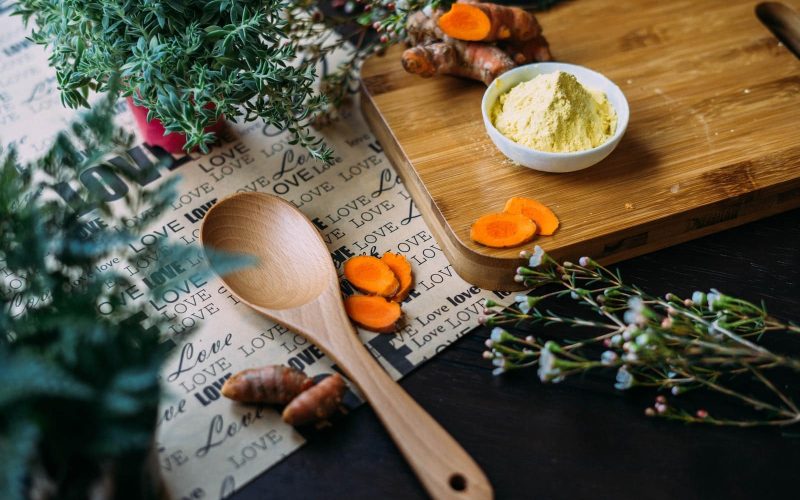Turmeric is one of the most beloved spices in the world and is used in various cuisines from around the globe.
However, not everyone has access to turmeric or wants to use it in their recipes. Fortunately, several good substitutes for turmeric can be used instead of spice.
In our post, we will explore the top substitutes for turmeric and how they can be used in recipes.
If you’re looking for alternative turmeric, you’ve come to the right place. Turmeric is a popular spice often used in Indian cuisine, but it’s not always easy to find in regular grocery stores.
Fortunately, several great substitutes for turmeric can be used in its place.
In our blog post, we will discuss the substitutes for turmeric and how they can be used in place of this popular spice.
With these substitutes, you can make delicious dishes with the flavors and health benefits of turmeric without having to search far and wide for it.
1. Sweet Paprika
Sweet Paprika is first on our list of substitutes for turmeric. Sweet paprika is an excellent choice when looking for a substitute for turmeric.
Sweet paprika is a milder, sweeter version of the spice used in traditional Hungarian cuisine.
This type of paprika provides a milder flavor and color than regular paprika, making it perfect for adding subtle flavor to dishes that don’t require intense spice.
It can also be used as one of the many substitutes for turmeric in curries, soups, and stews.
When using sweet paprika as a substitute for turmeric, use approximately one teaspoon for every two teaspoons of turmeric that is called for in a recipe.
2. Madras Curry Powder
In many recipes, Madras curry powder is also on our list of Substitutes for turmeric. It has a similar flavor and color and can be used as a one-to-one replacement.
Madras curry powder is a combination of spices such as coriander, cumin, black pepper, and chili peppers, as well as turmeric.
This gives it a much more complex flavor than regular turmeric, making it an ideal choice for dishes requiring more depth and complexity.
Madras curry powder is also usually spicier than turmeric, so if you want to add heat to a dish, this is a great option.
3. Ground Ginger/Ginger Powder
Ground ginger is not left from the list of great substitutes for turmeric. It has a similar flavor, aroma, and color and can easily be swapped in any recipe that calls for spice.
It has a slightly sharper flavor than turmeric but also offers many of the same health benefits, such as reducing inflammation and aiding digestion.
Additionally, ground ginger can be a more affordable substitute for turmeric than turmeric, making it a great alternative for budget cooks.
Ground ginger powder can also be used in place of turmeric in recipes. It’s more concentrated than ground ginger, and its flavor is more intense.
The color is less vibrant than turmeric, but it still offers many of the same health benefits and can add flavor to dishes.
If you’re looking for substitutes for turmeric that’s milder in taste, then ginger powder may be the perfect choice for you.
4. Saffron
Saffron is an expensive but flavorful spice that can be used as substitutes for turmeric in many recipes. It has a distinct, earthy flavor and a yellow-orange hue like turmeric.
It can be used to season dishes and add color to them, making it an attractive substitute for turmeric.
Additionally, it is believed to have medicinal properties, including anti-inflammatory, antibacterial, and antifungal benefits.
Saffron has a much milder flavor than turmeric, so you may need to use more of it to achieve the desired flavor.
As with all spices, when using saffron, it’s best to start with a small amount and adjust according to taste.
When using saffron as one of the amazing substitutes for turmeric, you can use it fresh or dried.
The dried form of saffron should be ground into a powder before use, making it easier to dissolve and incorporate into recipes.
Fresh saffron is also available and can be used like the dried form, although the flavor will be much more intense.
Whatever type of saffron you choose, remember to use it sparingly – a little goes a long way!
5. Safflower
Safflower is a perfect alternative for those looking for a substitute for turmeric.
It is derived from the Carthamus Tinctorius plant and contains a compound called thiocyanate with anti-inflammatory effects.
It also provides an orange-yellow hue to dishes, just like turmeric does. Safflower can be used as a substitute for recipes where turmeric is called for.
It is a great option for those looking for a natural and effective way to add flavor and color to their dishes without using turmeric.
Regarding nutrition, safflower is a great alternative to turmeric because it is high in fiber, vitamins A, C, and E, minerals, omega-6 fatty acids, and protein.
It has antioxidant properties, as well as anti-inflammatory benefits. In addition, safflower helps boost immunity and digestion and can help reduce cholesterol levels in the body.
All these health benefits make safflower one of the excellent substitutes for turmeric.
6. Dry Mustard
Dry mustard is an excellent alternative for turmeric, especially when you’re in a pinch and need to add flavor and color to your dish.
Dry mustard has a slightly bitter taste and provides a nice yellow hue to foods that may otherwise lack vibrant color.
In addition to its flavor and color, dry mustard substitutes for turmeric contain antioxidants, which can benefit your health.
Although it won’t provide the same health benefits as turmeric, it can still offer nutritional value to any dish you prepare.
When using dry mustard as a substitute for turmeric, it is important to remember that the flavor can be quite strong.
To counteract this, you may want to reduce the dry mustard you use and increase other flavors, such as garlic or onion powder.
You can also experiment with adding different spices or herbs to balance out the flavor of the dry mustard.
Remember that this will likely result in a different flavor profile than what you would get from using turmeric.
7. Mustard Seeds
Mustard seeds are a great alternative for replacing the flavor and aroma of turmeric in dishes.
Mustard seed substitutes for turmeric have a pungent, slightly bitter taste and a strong aroma similar to turmeric.
They can be used in curries, sauces, soups, salads, and other dishes. Ground mustard seeds can also be used as a substitute for turmeric.
The ground mustard seeds will have a milder flavor than the whole mustard seeds and will also impart a yellow color to the dish, similar to turmeric.
Mustard seed substitutes for turmeric are highly antioxidants and provide various health benefits, including improving digestion and reducing inflammation.
They should be added at the beginning of cooking to allow their flavor to develop fully.
In conclusion, mustard seeds are an excellent choice for replacing the flavor and aroma of turmeric in dishes.
They have a pungent and slightly bitter taste with a strong aroma similar to turmeric.
Ground mustard seeds can also be used as an alternative, providing a milder flavor and a yellow color to the dish.
Mustard seeds are high in antioxidants and offer numerous health benefits.
When used in cooking, they should be added at the beginning of the cooking process to allow their full flavor to develop.
8. Curry Powder
Curry powder is an easy and convenient substitute for turmeric to use when cooking.
Curry powder is a blend of many spices, including turmeric, cumin, coriander, fenugreek, and chili powder, that can help add complexity and depth of flavor to a dish.
The ratio of spices in the blend can vary greatly depending on the recipe, but generally, turmeric will be the dominant flavor.
If you don’t have fresh turmeric but want to enjoy its distinctive flavor, reach for some curry powder instead.
When substituting curry powder for fresh turmeric in a recipe, be sure to adjust the other seasonings since curry powder already contains a mix of flavors.
A good rule of thumb is to reduce the other seasonings by about one-third of their normal amount.
For example, if a recipe calls for one teaspoon of turmeric and one teaspoon of cumin, you would use two teaspoons of curry powder and only half a teaspoon of cumin.
Remember that curry powder can be quite spicy, so you may want to start with a smaller quantity than the recipe calls for and adjust the seasoning to taste.
9. Turmeric Paste
Turmeric paste is an easy and convenient way to use turmeric as a substitute. It is made by boiling equal parts of turmeric powder and water until it becomes a thick paste.
The paste can be used directly in recipes in place of ground turmeric, or a teaspoon can be mixed with a tablespoon of oil to make a paste that can be used as a marinade or rub for meats and vegetables.
Turmeric paste is also great for making sauces, curries, and soups.
Additionally, substitutes for turmeric paste can be stored in the refrigerator for up to two weeks, making it a great way to keep fresh turmeric on hand for all your cooking needs.
10. Garam Masala
Garam Masala is a blend of spices used in Indian cuisine and can be a great substitute for turmeric.
The typical spices found in a garam masala mix include cinnamon, cumin, coriander, cardamom, black pepper, clove, nutmeg, mace, and bay leaves. This mix of spices provides a deep and complex flavor that resembles turmeric.
However, it is important to remember that garam masala is much more pungent than turmeric.
When using it as a substitute for turmeric, the amount should be adjusted accordingly to avoid overpowering the dish.
11. Ground Cumin
Ground cumin is an excellent substitute for turmeric and can be used to add flavor and color to a variety of dishes.
Cumin is a popular spice used in Indian, Middle Eastern, and Latin American cuisines and adds a warm, earthy flavor.
It’s also a great source of antioxidants, essential minerals, and vitamins like iron, zinc, and magnesium.
Ground cumin is a great alternative to turmeric and can be used in various ways, such as in curries, soups, marinades, and rubs.
Additionally, it’s commonly used as an ingredient in garam masala, the famous Indian spice blend.
When substituting turmeric with cumin, use only half the amount called for in the recipe to avoid overpowering the flavors.
12. Smoked Paprika + Mace
Smoked paprika and mace are two spices that, when combined, can serve as a flavorful and effective substitute for turmeric.
Smoked paprika substitutes for turmeric, make the blend earthy, while mace adds a slight sweetness. This blend is great for curries, soups, and other savory dishes.
When using these blends as substitutes for turmeric, start with just half of the recommended amount of turmeric in the recipe and gradually increase it to the desired level of flavor.
To get the most out of this blend, try roasting the smoked paprika and mace before adding them to your dish for an even more complex flavor.
13. Annatto
Annatto, a spice derived from the reddish-orange achiote tree seed, is an ideal substitute for turmeric.
Not only is annatto a viable option to replace the flavor of turmeric, but its earthy flavor is also rich in vitamins and minerals.
It has a slightly sweet taste with subtle hints of pepper and nutmeg. Annatto substitutes for turmeric can be added to dishes that usually call for turmeric, like curries or soups, or as a topping for fish and vegetables.
While annatto doesn’t have the same health benefits as turmeric, it is still packed with antioxidants and fiber.
Annatto may be a perfect choice for those who want to give their dishes a color boost while still getting the flavor of turmeric.
Its natural orange hue can add a beautiful pop of color to your meals.
The intensity of its color can be manipulated through various techniques, including boiling, steaming, or grinding the seed.
Annatto is a great substitute for turmeric to add flavor and flair to your dish.
14. Galangal Powder
Finally, on our list, Galangal powder is a dried root of the plant known as Amomum Cardamomum, related to ginger.
It has a sweet and spicy flavor similar to turmeric, making it an ideal substitute for spice in recipes.
Galangal powder substitutes for turmeric have antioxidant and anti-inflammatory properties and can help to reduce cholesterol levels.
The powder is used extensively in Indian cooking, often as substitutes for turmeric or in place of other spices like cumin and coriander.
It is a great addition to curry dishes, soups, stews, and more. Galangal powder can also be added to tea or coffee to boost flavor.
Conclusion
Turmeric is a versatile and powerful herb with many health benefits, but it can be difficult to find in stores or work with.
Fortunately, several substitutes for turmeric offer similar health benefits as turmeric and make excellent substitutes.
Our blog post has looked at the great substitutes for turmeric, such as ginger, cumin, etc., as listed above.
We hope you’ve read to learn more about these substitutes for turmeric and how they can enhance the flavors of your favorite dishes.








